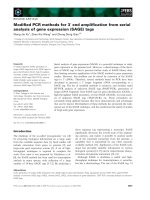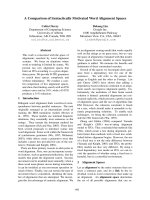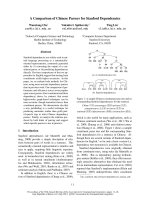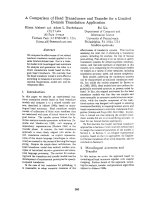báo cáo khoa học: "Experimental comparison of methods for simultaneous selection of two correlated traits in Tribolium. 2. Index selection and independent culling levels : a replicated single generation test" potx
Bạn đang xem bản rút gọn của tài liệu. Xem và tải ngay bản đầy đủ của tài liệu tại đây (483.21 KB, 9 trang )
Experimental
comparison
of
methods
for
simultaneous
selection
of
two
correlated
traits
in
Tribolium.
2.
Index
selection
and
independent
culling
levels :
a
replicated
single
generation
test
J.L. CAMPO
Carmen
RODRIGUEZ
Departamento
de
Genetica
Cuantitativa
y
Mejora
Animal,
Instituto
Nacional
de
Investigaciones
Agrarias,
Carretera
de
La
Coruna
Km
7,
28040
Madrid,
Spain
Summary
Index
selection
(I)
was
compared
with
independent
culling
levels
(N)
in
ten
replicates
of
a
single
generation
selection
experiment.
Two
correlated
traits,
egg
laying
between
7
and
11
days
after
adult
emergence
and
adult
weight
at
12
days,
were
selected
in
Tribolium
castaneum.
Selection
criteria
included
family
means
for
egg
laying
and
individual
phenotypic
values
for
adult
weight.
The
response
to
index
selection
was
greater
than
the
response
to
independent
culling
levels
for
the
aggregate
genotype
(8.80,
4.38)
and
the
difference
was
highly
significant
(P
<
.001).
The
predicted
response
to
independent
culling
levels
was
slightly
less
than
that
for
index
selection
for
the
aggregate
genotype.
The
very
large
difference
found
in
the
index
line
relative
to
culling
level
line
could
be
due
to
the
fact
that
family
selection
was
used
for
egg
laying.
Responses
obtained
for
both
individual
traits
were
also
greater
in
the
selection
index
line,
and
the
difference
was
significant
(P
<
.001)
for
egg
laying
(8.13,
3.96)
but
not
for
adult
weight
(0.67, 0.42).
A
greater
response
would
be
expected
in
the
selection
index
line
for
each
individual
trait
when
optimum
culling
proportions
are
used
in
the
culling
levels
line.
Independent
culling
levels
should
be
considered
in
practice
as
a
relatively
simple
but
inefficient
selection
method
to
improve
egg
laying
and
adult
weight.
Key
words :
Index
selection,
independent
culling
levels,
correlated
traits,
single
generation
test,
Tribolium
castaneum.
Résumé
Comparaison
expérimentale
de
méthodes
de
sélection
pour
l’amélioration
de
deux
caractères
corrélés
chez
Tribolium.
2.
Sélection
sur
index
et
sélection
par
niveaux
indépendants :
une
expérience
sur
une
génération,
avec
répétition
On
a
comparé
la
sélection
sur
index
(I)
et
la
sélection
par
niveaux
indépendants
(N)
dans
une
expérience
de
sélection
sur
une
génération
comportant
10
répétitions.
On
a
réalisé
la
sélection
chez
Tribolium
castaneum
sur
2
caractères
corrélés :
la
ponte
d’oeufs
du
7e
au
11
e
jour
après
l’émergence
de
l’adulte
et
le
poids
de
l’adulte
à
l’âge
de
12
jours.
Les
critères
de
sélection
faisaient
intervenir
les
moyennes
de
familles
pour
la
ponte
d’oeufs
et
les
valeurs
phénotypiques
individuelles
pour
le
poids
adulte.
La
réponse
à
la
sélection
sur
index
est
plus
grande
que
celle
à
la
sélection
par
niveaux
indépendants
pour
le
génotype
global
(8,80
et
4,38
respectivement),
la
différence
étant
hautement
significative
(P
<
0,001).
La
réponse
prédite
à
la
sélection
par
niveaux
indépendants
est
légèrement
inférieure
à
la
réponse
prédite
à
la
sélection
sur
index
pour
le
génotype.
L’importante
différence
observée
entre
les
réponses
à
la
sélection
sur
index
et
à
la
sélection
par
niveaux
indépendants
pourrait
être
due
à
l’utilisation
d’une
sélection
familiale
pour
la
ponte
d’ceufs.
Les
réponses
obtenues
sur
chacun
des
2
caractères
sont,
elles
aussi,
plus
importantes
avec
la
sélection
sur
index
qu’avec
la
sélection
par
niveaux
indépendants,
la
différence
étant
significative
(P
<
0,001)
pour
la
ponte
d’oeufs
(8,13
et
3,96
respectivement),
mais
non
significative
pour
le
poids
adulte
(0,67
et
0,42
respectivement).
La
réponse
attendue
pour
chacun des
caractères
est
plus
grande
dans
la
sélection
sur
index
que
dans
la
sélection
par
niveaux
indépen-
dants
avec
des
intensités
de
sélection
optimales.
En
pratique,
la
sélection
par
niveaux
indépendants
doit
être
considérée
comme
une
méthode
assez
simple
mais
inefficace
pour
améliorer
la
ponte
d’oeufs
et
le
poids
adulte.
Mots
clés :
Sélection
sur
index,
sélection
par
niveaux
indépendants,
caractères
corrélés,
expé-
rience
sur
une
génération,
Tribolium
castaneum.
I.
Introduction
Multiple
trait
selection
may
be
carried
out
by
3
main
methods :
index
selection,
independent
culling
levels
and
tandem
selection.
It
has
been
theoretically
shown
(HAZEL
&
LusH,
1942 ;
YOUNG,
1961)
that
the
index
method
is
never
less
efficient
than
that
of
independent
culling
levels,
though
in
some
cases
it
may
be
no
more
efficient ;
similarly,
independent
,culling
is
never
less
efficient
than
tandem
selection.
A
further
method,
selection
of
extremes
(A
BPLANALP
,
1972),
is
theoretically
more
efficient
than
tandem
selection,
and
falls
below
independent
culling
levels
when
the
proportion
selected
is
less
than
0.50.
The
expected
results
about
index,
independent
culling
levels
and
tandem
methods
of
selection,
have
been
experimentally
confirmed
by
S
EN
&
R
OBERTSON
(1964),
selecting
for
bristle
scores
in
Drosophila,
and
DooLn-rt,E
et
al.
(1972),
selecting
for
litter
size
and
weight
gain
in
mice,
even
though
they
did
not
obtain
significant
differences
among
the
methods.
Experimental
results
by
RnsMUSOrr
(1964),
selecting
for
bristle
scores
in
Drosophila,
are
in
agreement
with
theoretical
expectations
for
tandem
selection,
but
the
comparison
between
index
and
independent
culling
methods
is
contradictory
in
the
2
experiments
that
were
made.
All the
above
comparisons
consisted
of
multigeneration
experiments.
The
use
of
replicated
single
generation
experiments
to
obtain
selection
responses
which
could
be
considered
as
accurate
estimates
of
theoretical
responses,
has
been
emphasised
by
B
OHREN
(1975).
These
experiments
have
been
applied
to
check
the
genetical
theory
concerning
single
trait
selection
(WiLSOrr,
1974 ;
G
ARWOOD
et
al. ,
1980 ;
G
ARWOOD
&
LowE,
1981)
but
not
multiple
trait
selection
theory.
Since
those
experimental
results
comparing
the
best
2
methods
of
multiple
trait
selection
have
not
conclusively
shown
the
theoretical
advantage
of
the
index
over
the
independent
culling
method,
in
the
present
experiment
selection
was
practised
for
egg
laying
and
adult
weight
of
Tribolium,
comparing
index
selection
and
independent
culling
levels
in
ten
replicates
of
a
single
generation
of
selection.
The
comparison
between
index
and
a
modified
tandem
selection
has
been
previously
considered
by
OR
ozco et
al.
(1980)
for
these
same
traits,
obtaining
results
in
agreement
with
theoretical
expectations.
II.
Material
and
methods
The population
of
Tribolium
castaneum
used
in
this
study
originated
from
the
Consejo
stock.
During
the
experiment,
lines
were
maintained
in
an
incubator
at
a
temperature
of
33
°C
and
a
relative
humidity
of
70
p.
100.
The
culturing
medium
used
consisted
of
95
p.
100
wheat
flour
and
5
p.
100
brewer’s
yeast.
Ten
replicates
were
used
in
this
experiment.
The
unselected
generation
0
of
each
line,
in
each
of
the
10
replicates,
was
produced
by
mating
males
and
females
randomly
selected
from
the
base
population.
The
parents
of
the
selected
generation
1
were
picked
from
generation
0
by
the
appropriate
selection
method
and
were
mated
in
such
a
way
that
sib
matings
were
avoided.
The
2
lines
in
each
replicate
were
differentiated
by
the
method
of
selection :
index
(I)
or
independent
culling
levels
(N).
Each
line
was
propagated
by
25
single-pair
matings
per
generation ;
5
male
and
5
female
offspring
were
individually
weighed
and
the
females
scored
for
egg
laying.
With
25
males
and
25
females
selected
each
generation,
the
proportion
selected
was
0.20
in
both
lines.
The
2
traits
selected,
egg
laying
between
7
and
11
days
after
adult
emergence
and
adult
weight
at
12
days,
were
given
equal
weights
in
the
aggregate
genotype.
The
unit
of
measurement
for
adult
weight
was
the
tenth
of
a
milligram.
The
index
coefficients
have
been
calculated
from
previous
parameters
estimates
(C
AMPO
&
R
ODRIGUEZ
,
1985).
The
selection
index
in
the
I
line
was,
in
females :
md,
in
males :
where
Xl
and
x2
stand
for
the
mean
of
full-sib
families
for
egg
laying
and
the
individual
phenotypic
value
for
adult
weight,
respectively.
In
the
N
line,
the
males
and
females
were
separately
ranked
for
k,
and
X2
,
then
selection
was
simultaneously
practised
in
the
2
rankings
till
the
proportion
selected
was
achieved
(BELL
&
B
URRIS
,
1973).
Comparison
between
responses
to
selection
obtained
in
each
line
was
made
by
analysis
of
variance,
mixed
model,
lines
being
considered
as
a
fixed
factor
and
replicates
as
a
random
factor.
Estimates
of
heritabilities
and
genetic
and
phenotypic
correlations
for
both
traits
in
the
base
population
were
obtained
by
analysis
of
variance-
covariance
of
full-sib
families.
The
expected
response
to
selection
for
each
trait
separately
(AG
I,
AG
2)
and
for
tht
aggregate
genotype
(OH)
have
been
previously
given
by
C
AMPO
&
R
ODRIGUEZ
(1985)
in
the
I
line.
The
expected
responses
in
N
line
are,
in
females :
and,
in
males :
where
h2,
or’
and
r?
2
stand
for
the
heritabilities,
phenotypic
variances
and
genetic
correlation
coefficient
respectively,
n
is
the
family
size
for
egg
laying,
and :
The
phenotypic
correlation
between
the
family
mean
for
egg
laying
and
the
individual
adult
weight
is,
in
females :
and,
in
males :
where
r
12
stands
for
the
phenotypic
correlation
coefficient.
The
selection
intensities
for
each
trait
(i&dquo;
i2)
have
been
given
by
YOUNG
&
W
EILER
(1960).
III. Results
The
parameters
of
the
base
population
are
shown
in
table
1.
Estimates
agree
very
well
with
those
previously
reported
by
us
(C
AMPO
&
R
ODRIGUEZ
,
1985)
in
the
Consejo
population.
Egg
laying
showed
a
much
greater
variation
than
adult
weight,
both
traits
having
intermediate
values
of
heritability,
a
little
higher
for
adult
weight.
There
were
positive
phenotypic
and
genetic
correlations,
the
phenotypic
coefficient
being
smaller
than
the
genetic
one.
Females
were
heavier
than
males ;
however,
phenotypic
and
genetic
variances
in
males
and
females
were
homogeneous
and
therefore
both
sexes
were
analyzed
together
in
this
study.
The
observed
responses
to
selection for
the
aggregate
genotype
are
indicated
in
table
2,
for
the
10
single
generation
tests.
In
no
replicate
did
the
index
line
fail
to
produce
positive
response
for
the
aggregate
genotype,
while
the
independent
culling
line
produced
negative
response
in
2
replicates
and
produced
practically
no
change
in
another
replicate.
Mean
progress
from
each
method
of
selection
indicates
that
the
index
line
exceeded
the
independent
culling
line,
being
about
twice
as
good.
In
all
replicates
selection
response
was
greater
in
the
I
line
than
in
the
N
line.
The
analysis
of variance
of
the
selection
progress
realized
is
shown
in
table
3.
Selection
methods
and
replicates
were
highly
significant
sources
of
variation
(P
<
.001)
when
tested
by
the
interaction
variance.
The
validity
of
the
significance
between
replicates
assumed
the
absence
of
significant
line
x
replicate
interaction.
_
The
observed
responses
to
selection for
each
individual
trait
are
also
indicated
in
table
2.
For
egg
laying,
the
index
line
had
positive
selection
response
in
all
replicates ;
the
independent
culling
line
showed
positive
response
only
in
7
replicates,
having
negative
response
in
3
other
replicates.
The
response
was
always
larger
in
the
index
line
than
in
the
independent
culling
line.
The
difference
between
average
gains
in
egg
laying
was
significant
(tabl.
3).
The
mean
value
for
adult
weight
increased
in
all
replicates
of
the
index
line,
increasing
in
7
replicates
of
the
independent
culling
line
and
having
negative
response
in
the
other
3
replicates.
Even
though
the
index
line
showed
a
trend
to
be
superior
to
the
independent
culling
line,
the
difference
among
mean
gains
was
not
significant.
The
above
results
show
that
the
response
to
selection
in
the
aggregate
genotype
was
mainly
due
to
an
increase
in
egg
laying.
The
higher
homogeneity
observed
in
the
unselected
generation
0
means
for
adult
weight
than
for
egg
laying
was
consistent
with
the
variation
found
in
the
base
population
for
each
trait.
The
coefficients
of
variation
of
these
mean
values
were
about
3
p.
100
and
12
p.
100
for
adult
weight
and
egg
laying,
respectively.
The
selection
intensities
for
egg
laying
and
adult
weight
in
both
lines
are
shown
in
table
4.
In
the
independent
culling
line
the
intensity
of
selection
was
larger
for
adult
weight
than
for
egg
laying.
The
observed
selection
intensities
do
not
agree
with
those
predicted
(YOUNG
&
W
EILER
,
1960).
The
expected
values
for
egg
laying
and
adult
weight
range
approximately
from
(0.40, 1.40),
when
the
selection
pressure
is
different
in
egg
laying
and
in
adult
weight,
to
(1.00,
1.00)
when
it
is
identical
in
both
traits.
If
an
intensity
of
selection
approximately
equal
to
0.80
is
given
for
adult
weight,
a
value
greater
than
1.00
is
predicted
for
egg
laying.
In
the
line
selected
by
independent
culling
levels
the
selection
differentials
for
egg
laying
exceeded
those
for
adult
weight,
as
was
expected
because
of
the
greater
value
for
the
phenotypic
variance of
the
family
means
for
egg
laying
than
for
the
phenotypic
variance
of
the
adult
weight.
Realized
heritabili-
ties
were
0.48
for
egg
laying
and
0.23
for
adult
weight ;
in
both
cases
the
realized
values
are
smaller
than
those
calculated
in
the
base
population
(0.60
and
0.46
respecti-
vely).
The
average
value
throughout
the
10
replicates
of
the
intensities
of
selection
obtained
in
the
index
line
(tabl.
4)
was
slightly
smaller
than
the
theoretical
value
(1.39).
Selection
differentials
observed
in
each
replicate
of
the
line
selected
by
the
index
method
were
similar
to
those
previously
obtained
by
us
(C
AMPO
&
R
ODRIGU
EZ,
1985)
in
the
theoretical
index
line.
Realized
heritability
was
0.67
and
it
agrees
very
well
with
the
heritability
of
the
selection
index
calculated
in
the
base
population
which
was
0.75.
As
in
the
independent
culling
line,
the
intensity
of
selection
was
larger
for
adult
weight
than
for
egg
laying
(tabl.
4).
The
secondary
selection
intensities
for
egg
laying
from
the
index
line
were
in
general
smaller
than
the
corresponding
values
obtained
in
the
independent
culling
line,
while
selection
intensities
for
adult
weight
were
greater
in
the
index
line.
IV.
Discussion
Concerning
the
aggregate
genotype
the
selection
index
line
had
a
significantly
better
response
than
the
independent
culling
line,
showing
that
the
index
was
a
superior
method
to
improve
egg
laying
and
adult
weight
simultaneously.
The
index
also
gave
a
greater
response
for
both
individual
traits,
the
lines
differing
significantly
for
egg
laying
only.
Expected
responses
to
selection
per
generation
have
been
calculated
from
previous
parameter
estimates
(C
AMPO
&
RO
DR
IGUEZ
,
1985),
not
those
given
in
table
1,
since
the
index
coefficients
were
calculated
with
these
previous
estimates.
Expectations
of
gains
using
the
parameters
of
the
base
population
(tabl.
1)
were
very
similar.
In
theory,
a
greater
response
should
be
expected
with
index
selection
than
with
independent
culling
selection
for
the
aggregate
genotype
(H
units).
The
greatest
response
with
independent
culling
selection
is
expected
when
the
intensity
of
selection
is
approximately
1.2 for
egg
laying
and
0.8
for
adult
weight ;
it
turns
out
to
be
8.65
(when
the
intensity
of
selection
is
equal
for
both
traits
the
expected
response
is
8.56).
Since
the
theoretical
expected
response
is
8.95
for
index
selection
the
relative
efficiency
of
independent
culling
should
be
approximately
0.96.
Independent
culling
levels
performed
surprisingly
badly.
The
very
large
difference
actually
found
could
be
due
to
the
fact
that
family
selection
was
used
for
egg
laying
under
selection
with
independent
culling
levels ;
it
could
have
resulted
in
unequal
selection
intensities
for
the
2
traits
and
thus
put
culling
level
selection
at
a
possible
disadvantage
in
selection
efficiency.
Moreover,
the
total
response
to
selection
in
the
aggregate
genotype
was
mainly
due
to
egg
laying.
On
the
other
hand,
the
selection
scheme
used
under
independent
culling
levels
(BELL
&
Bums,
1973)
deviates
slightly
from
that
originally
developed
by
HAZEL
&
LusH
(1942)
and
could
affect
the
assump-
tions
and
the
solutions
provided
by
YOUNG
&
W
EILER
(1960)
for
computing
the
expected
genetic
changes.
Selection
intensities
were
not
first
optimized
theoretically,
even
though
the
observed
value
for
adult
weight
was
near
the
optimum
combination
of
culling
while
the
observed
value
for
egg
laying
was
very
far.
The
superiority
of
the
index
method
with
respect
to
independent
culling
levels
was
shown
in
all
10
replicates ;
that
consistency
in
the
relative
superiority
for
the
selection
index
gives
a
great
accuracy
to
the
conclusions
of
the
experiment.
The
expected
response
for
each
individual
trait,
when
the
intensity
of
selection
is
approximately
1.2
for
egg
laying
and
0.8
for
adult
weight,
should
be
also
smaller
in
the
independent
culling
line.
It
turns
out
to
be
7.29
for
egg
laying
compared
with
the
expected
one
in
the
selection
index
line
(7.47)
and
1.35
for
adult
weight
compared
with
1.50.
The
relative
efficiency
expected
in
the
N
line
is
0.98
for
egg
laying
and
0.90
for
adult
weight.
The
superiority
of
the
index
method
compared
with
the
independent
culling
levels
one
which
was
found
in
this
study
agrees
with
the
general
results
reported
by
HAZEL
&
LUSH
(1942)
and
with
the
theoretical
results
obtained
by
YOUNG
(1961)
concerning
the
simultaneous
improvement
of
correlated
traits
selected
with
the
same
economic
weights.
Since
efficiency
of
culling
level
selection
relative
to
index
selection
increases
with
increasing
total
selection
intensity,
with
20
p.
100
total
selection
it
could
be
expected
culling
level
selection
to
be
relatively
disadvantageous.
On
the
other
hand,
the
superio-
rity
of
the
index
is
maximum
when
the
traits
are
of
equal
importance
and
it
is
higher
when
the
phenotypic
correlation
is
low.
The
proportion
of
realized
versus
predicted
response
for
the
aggregate
genotype
was
not
very
high
in
the
independent
culling
line
(0.50
approximately)
as
a
consequence
of
the
lack
of
positive
response
in
3
replicates.
If
these
replicates
were
not
included
in
the
analysis,
the
observed
response
to
selection
would
be
6.88,
very
close
to
the
expected
response
calculated
before.
The
negative
selection
responses
of
some
repli-
cates
in
the
culling
level
line
could
lead
to
the
conclusion
that
single
generation
selection
experiments
do
not
fully
explore
the
potential
spectrum
of
factors
entering
real
situations
where
selection
is
long-term
and
with
highly
heritable
traits
results
in
substantial
responses.
However,
the
proportion
of
realized
versus
predicted
response
for
the
aggregate
genotype
was
very
high
in
the
index
line
(0.98) ;
this
proportion
is
clearly
different
from
that
obtained
by
us
in
a
multigeneration
experiment
(C
AMPO
&
R
ODRI
-
GUEZ
,
1985).
These
results
could
confirm
the
value
of
highly
replicated
single
genera-
tion
experiments
for
testing
genetic
theory,
as
was
emphasized
by
B
OHREN
(1975).
In
experiments
of
this
type,
the
problem
of
differential
inbreeding
levels
can
be
eliminated
and
the
net
effect
of
differential
population
sizes
should
be
of
no
consequence.
Other
experiments
involving
single
generation
selection
have
been
applied
to
test
the
effi-
ciency
of
selection
methods
to
improve
a
single
trait.
In
agreement
with
the
present
study
G
ARWOOD
et
al.
(1980)
found
significant
differences
between
individual
and
family
selection
in
chickens.
In
contrast
to
us
WtLSOrr
(1974),
comparing
individual,
family
and
combination
selection
in
Tribolium,
and
G
ARWOOD
&
LowE
(1981),
comparing
family
and
combination
selection
in
chickens,
did
not
detect
significant
differences
between
methods
of
selection.
The
principal
consequences
which
can
be
extracted
from
the
present
study
are
that
given
the
special
conditions
of
this
experiment
(intermediate
values
of
heritability,
positive
phenotypic
and
genetic
correlations,
equal
economic
weights,
total
selection
intensity
not
very
high
and
family
selection
for
one
trait),
the
selection
index
method
is
clearly
better
than
independent
culling
levels.
The
small
efficiency
showed
by
the
independent
culling
levels
suggests
that
this
method
should
not
be,
in
these
conditions,
applied
in
practical
breeding
programs,
even
though
the
advantages
of
minimal
record
maintenance
and
animal
handling
increase
its
attraction.
On
the
other
hand,
the
arbitrary
culling
levels
sometimes
applied
can
be
very
far
from
the
optimum
values.
Received
May
17,
1985.
Accepted
April
9,
1986.
Acknowledgements
We
are
grateful
to
Dr.
F.
OR
ozco
and
Dr.
C.
LoPE
z-F
AN
JUL
for
their
advices
and
help
in
many
aspects
of
the
work.
References
A
BPLANALP
H.,
1972.
Selection
of
extremes.
Anim.
Prod.,
14,
11-15.
BELL
A.E.,
B
URRIS
M.J.,
1973.
Simultaneous
selection
for
two
correlated
traits
in
Tribolium.
Genet.
Res. ,
21,
29-46.
B
OHREN
B.B.,
1975.
Designing
artificial
selection
experiments
for
specific
objectives.
Genetics,
80,
205-220.
C
AMPO
J.L.,
R
ODRIGUEZ
M.C.,
1985.
Experimental
comparison
of
methods
for
simultaneous
selection
of
two
correlated
traits
in
Tribolium.
I.
Empirical
and
theoretical
selection
indexes.
Theor.
Appl.
Genet.,
71,
93-100.
D
OOLI
TTLE
D.P.,
W
ILSON
S.P.,
H
ULBERT
L.L.,
1972.
A
comparison
of
multiple
trait
selection
methods
in
the
mouse.
J.
Hered., 63,
366-372.
G
ARWOOD
V.A.,
LowE
P.C.,
B
OHREN
B.B.,
1980.
An
experimental
test
of
the
efficiency
of
family
selection
in
chickens.
Theor.
Appl.
Genet.,
56,
5-9.
G
ARWOOD
V.A.,
LowE
P.C.,
1981.
A
comparison
of
combination
and
family
selection
in
chickens.
Poultry
Sci.,
60,
285-288.
HAZEL
L.N.,
LUSH
J.L.,
1942.
The
efficiency
of
three
methods
of
selection.
J.
Hered.,
33,
393-
399.
OR
ozco
F.,
C
AMPO
J.L.,
F
UENTES
M.C.,
L
OPEZ
-F
ANIUL
C.,
T
AGARRO
P.,
1980.
A
comparison
between
crossbreeding
and
index
selection
for
the
simultaneous
improvement
of
two
traits
in
Tribolium
castaneum.
In :
R
OBERTSON
A.
(ed.),
Selection
Experiments
in
Laboratory
and
Domestic
Animals,
37-52.
Commonwealth
Agricultural
Bureaux,
U.K.
R
ASMUSON
M.,
1964.
Combined
selection
for
two
bristle
characters
in
Drosophila.
Hereditas,
51,
231-256.
S
EN
B.K.,
R
OBERTSON
A.,
1964.
An
experimental
examination
of
methods
for
the
simultaneous
selection
of
two
characters
using
Drosophila
melanogaster.
Genetics,
50,
199-209.
W
ILSON
S.P.,
1974.
An
experimental
comparison
of
individual,
family
and
combination
selection.
Genetics,
76,
823-836.
YOUNG
S.S.Y.,
1961.
A
further
examination
of
the
relative
efficiency
of
three
methods
of
selection
for
genetic
gains
under
less
restricted
conditions.
Genet.
Res.,
2,
106-121.
YOUNG
S.S.Y.,
W
EILER
H.,
1960.
Selection
for
two
correlated
traits
by
independent
culling
levels.
J.
Genetics,
57,
329-338.









